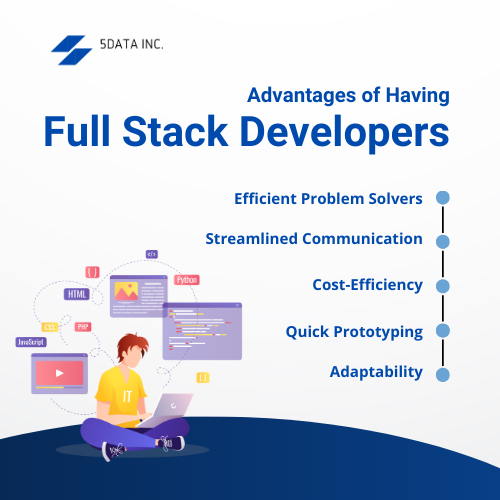What we cover in this blog
What Is Front-End And Back-End Development?
Software development is a multifaceted domain, and at its core, it’s split into two fundamental aspects: back-end and front-end web development. Let’s have a better understanding of their job roles and why they are indispensable for creating a responsive design:Front-End Development:
Front-end development, or client-side development, primarily deals with the visible part of a web application that users interact with. The front-end developer encompasses everything the user sees and interacts with on their screens.- Role in Creating User Interfaces: Front-end developer’s role is all about crafting captivating and user-friendly interfaces. It focuses on the visual aspects and usability of a website using markup languages and cascading style sheets. When you click a button, scroll through a webpage, or fill out a form, you’re engaging with the front end.
- Essential for Creating a Complete Web Application: Without front-end development, a web application would be just a bunch of data and code hidden in the digital abyss. Therefore, the front-end developer bridges the gap between the user’s actions and the multiple frameworks in the back end.
Back-End Development:
In contrast to the front-end, back-end web development operates behind the scenes on database technologies such as Microsoft SQL Server, Oracle, and MySQL. The back-end developer focuses on the server, databases, and all the intricate processes that occur when you interact with a website or app.- Role in Server-Side Development: Back-end developer acts like the engine room of enterprise software(s). It manages data storage, security, and server-side operations. When you log in to a website, make a purchase, or submit a form, the back-end handles all the server-related tasks, ensuring data is processed, stored, and delivered efficiently using scripting languages and javascript libraries.
- Equally Essential to Develop the Complete Application: A robust back-end is the backbone of any web application. It stores user data, ensures security, and handles server-side logic. Without it, front-end interfaces would be mere shells, incapable of performing the intricate tasks users expect from modern applications.
Who Are Full Stack Developers?
A full-stack developer is a well-rounded professional who possesses expertise in both front-end and back-end development. They are jacks of all trades in the app development world. A full-stack developer is like the conductor of the application development domain, capable of overseeing the entire project from start to finish. They can seamlessly switch by playing the role between front-end web developers and back-end developers.
Advantages of Having Full Stack Developers:
- Efficient Problem Solvers: Full-stack developers have a 360-degree view of application development. They can swiftly identify and resolve issues that span both the front-end and back-end programming languages, resulting in efficient load balancing.
- Streamlined Communication: Since they understand both aspects of development, full-stack development can bridge the communication gap between front-end and back-end teams. It fosters smoother collaboration, faster development cycles, and fewer misunderstandings.
- End-to-End Ownership: Full-stack developers can take ownership of an entire project, from conceptualizing the user interface to designing databases and handling server-side logic. This end-to-end control ensures a cohesive and integrated final product.
- Quick Prototyping: They are adept at rapidly prototyping ideas and bringing them to life. Full-stack developers can create functional prototypes to test concepts and gather feedback before investing in extensive development.
- Adaptability: The digital landscape is ever-evolving, and full-stack developers have the adaptability to stay current with the latest technologies and trends in both front-end and back-end development.
Achieve harmony in website development by partnering with the top application development company in the U.S.
The Importance of a Balanced Approach
Balancing back-end and front-end frameworks is like finding the perfect recipe for a delicious dish. In this section, we’ll highlight why this balance is crucial, how it ensures web pages run smoothly, and the key role played by full-stack developers in maintaining this balance:
1. Emphasizing the Need for Balance:
- Foundation of Software Development: Think of front-end and back-end development as the solid foundation of a house. Both are equally important and must work hand-in-hand to build something robust.
- User Experience: Front-end programming language ensures the user interface is engaging and easy to navigate, while back-end languages make sure everything behind the scenes functions smoothly.
- A Complete Package: A successful web application isn’t just about looking good using the hypertext markup language to look aesthetically pleasing, but a software engineer must make the website work efficiently.
2. Ensuring Seamless Applications:
- User Expectations: In today’s digital world, users expect website work to be fast, efficient, and visually appealing on cross platforms, especially mobile device(s). Achieving seamlessness requires a delicate balance between the front-end developer skills and the back-end programming languages.
- Data Management: The back-end infrastructure serves as the repository for data, housing the stored information, while the front-end represents the user interface and data presentation layer. A seamless operation of the back-end systems is imperative for the efficient delivery of data to end-users.
- Efficient Functionality: A great-looking front-end framework won’t suffice if the application is sluggish or prone to errors. Back-end performance is crucial for a web application to operate efficiently.
Elevate your web development with cutting-edge solutions by collaborating with the best software application development company.
3. Achieving Development Efficiency:
- Cross-Training Opportunities: Developers who understand both front-end and back-end aspects can enrich their skill set. This cross-training can lead to more versatile and adaptable teams.
- Scalability: A balanced approach provides a strong foundation for adding new features, providing scalability. As the application grows, a balanced development approach can handle increased complexity more effectively to fix bugs and errors.
Prime Highlights
In summary, the balance between front-end and back-end development goes beyond just ensuring seamless user interaction. It is also about achieving development efficiency scalability and leveraging the expertise of a company like 5DataInc. Much like a well-maintained bicycle gliding effortlessly forward, this balance ensures that the web developer(s) works cohesively, and it is essential for their success.
Balancing front-end and back-end development is simpler with the support of our application development services.

About the Author...
Almaas Saleem is a skilled software engineer from Kerala, India who currently resides in East Africa. She is passionate about technology and constantly seeks to learn more about it through reading and hands-on experience. Almaas excels in web development, design, automated testing software, ethical hacking, cybersecurity, and digital marketing. She also works as a technical writer for new businesses, managing various entities. Almaas is distinguished by her steadfastness and commitment to her work, which consistently yields excellent results.
